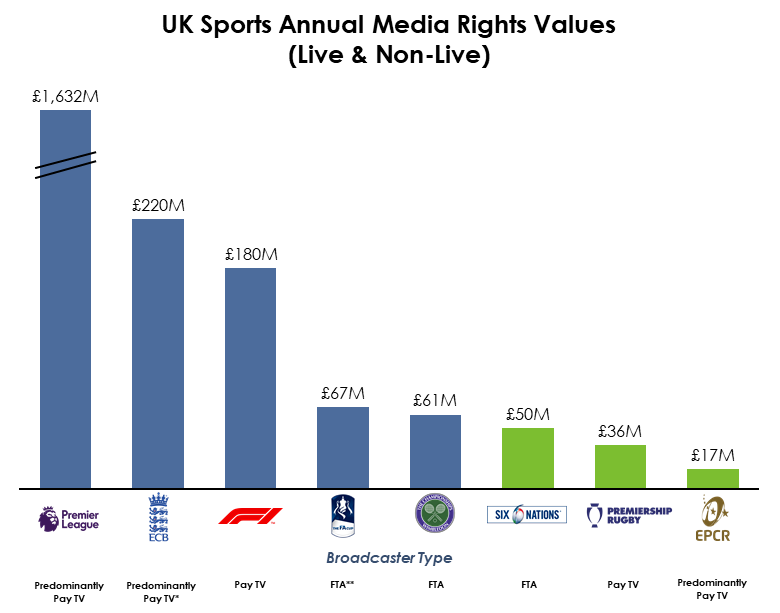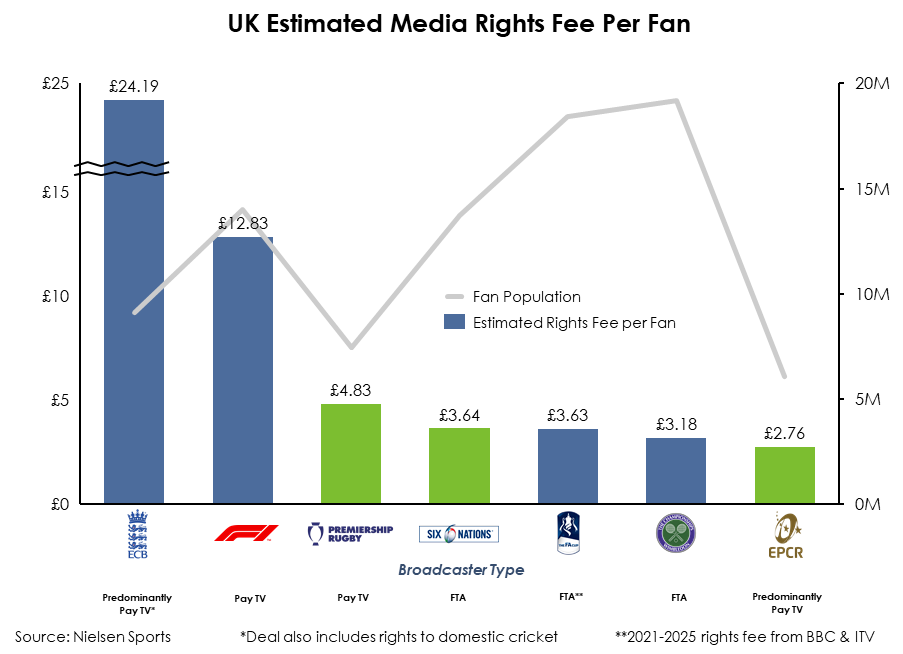
Analysis by Nielsen Sport shows that rugby’s broadcast and commercial income lags behind other mainstream sports in the UK despite commercially attractive fanbase and widespread interest in flagship competitions
- According to Nielsen’s Sports Fan Insights, rugby is the sixth largest sport in the UK with a fanbase of 12 million, favorable age and gender splits and widespread interest in flagship competitions such as the Six Nations
- Nielsen analysis indicates that Rugby Union in the UK may be underperforming on its broadcast and commercial income despite having strong interest levels and an attractive fanbase
- Rugby experiences several unique challenges which may be holding the sport back
- The current environment offers new opportunities for prospective investors; significant external investment and strategic measures can simplify and strengthen the rugby landscape and ultimately unlock previously untapped value, as witnessed through CVC’s recent investments
A new report released by Nielsen Sports, the global leader in sports industry analytics, suggests that rugby union has yet to fully capitalize on its commercial potential, with the growing involvement of private equity and venture capitalist firms offering the opportunity to change that, and a sign that they see untapped value in rugby union
The increased involvement of PE and VC firms has been driven principally by the fast growth in the sports and entertainment sector, with the industry growing at 7.4% CAGR over the last 3-5 years which is significant for any investor seeking healthy returns. Private equity firms are shrewd, business savvy operators who invest in sports franchises and leagues to acquire financial gains rather than trophies – the most notable example being CVC’s investment in Formula 1 in 2006 before exiting with a sizeable profit in 2017.
Rugby, more than most sports, has the potential to capitalize on the increased involvement of private equity and venture capitalist firms in the sports industry. It is an attractive proposition, evidenced by the investment in the sport over the last two years by CVC, who have invested £200m in exchange for a 27% share in Premiership Rugby; £120m in the Pro14 for a similar stake; and are involved in ongoing discussion with the Six Nations over a possible 14.5% share in the tournament. CVC continues to be linked with further investments, including notable properties in the Southern Hemisphere.
However, CVC’s involvement also points to a belief that rugby union may be undervalued and that it has the potential to markedly improve its commercial performance.
According to Nielsen’s Sports Fan Insights, rugby union is the six largest sport in the UK with a fanbase of 12 million which places it behind football and motorsports (including F1) but ahead of cricket. It has a younger fan base than that of F1, cricket and the general population, with 27% of fans falling into the 16-29 age bracket, compared to 24% for F1 and 26% for cricket and the general population.
However, despite rugby’s sizeable, mature and affluent fanbase – which appeals to younger and female audiences more than others – Rugby properties on average are generating lower rights yields in the UK than other comparable sports competitions. When compared to other major sports competitions, rugby union properties have significantly lower annual media rights values in the UK.

The Six Nations is the jewel in the Northern Hemisphere rugby calendar, with the annual tournament counting a fanbase in the UK larger than rugby union in general. Its 13.7 million fans put it in line with F1 (14 million) and ahead of England men’s cricket (9.1 million). However, whilst the Six Nations has remained on free-to-air TV, earning the Six Nations in the region of £50 million from its broadcast rights both Formula 1 and English men’s cricket has moved to pay TV generating approximately 4 times more broadcast revenue annually despite having similar interest levels.
Analysis shows the Six Nations delivers a lower rights fee per fan relative to that of F1 and cricket, which both benefit from pay TV. A potential switch to Pay TV could result in strong rights fee growth were they able to increase the relative rights fee per fan inline with other major rights holders.

It’s a similar story when it comes to commercial income, with the rugby sponsorship market in the UK and Ireland declining by a 6% CAGR between 2016 and 2019. This decline contrasts with the increase seen more generally across the wider UK market, with football enjoying a healthy growth of 8% CAGR over the same period. Rugby’s decline can be found in significant decreases in flagship sponsorships such as those of the Six Nations and English Premiership, which have fallen by nearly 30% and 20% respectively. Football on the other hand has seen its Premier League teams benefit from double digit growth in key sponsorships, such as Tottenham’s £40 million per season partnership with AIA and Everton’s new £10 million per season kit sponsorship with Hummel. Both examples represented a 25% increase on their previous deals. Elsewhere, the ECB doubled its kit sponsorship income when switching to New Balance during that period.
Phelan Hill, Head of Strategy & Consulting at Nielsen Sports, commented:
“Rugby faces some unique challenges which are possibly holding the sport back and preventing it from capitalizing on the commercial gains experienced by sports such as football, cricket and F1. There is a divide between the domestic and international game and various leagues and competitions operating in silos, with a disjointed global calendar which has bred a culture of self-interest and fragmented commercial and broadcast distribution.
“New investment and structural changes can lead to a more joined-up, substantial rugby proposition which would become more compelling for broadcasters and sponsors. Over time, we can expect to see new tournaments, the expansion of existing events and more crossover competitions between different leagues and hemispheres. We’ll also likely see greater investment in building the brands of the various rugby union properties around the world, generating more widespread interest from fans, broadcasters and sponsors and greater commercial revenues.”
Interested to know more?
Once you have completed the form, you will receive an email with a link to the report. If you do not receive an email, please check your spam folder. In any case, you can contact us at know@nielsen.com if you have any questions.